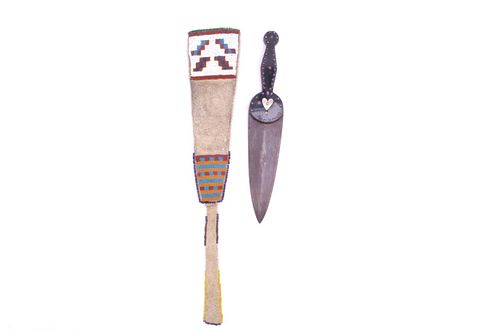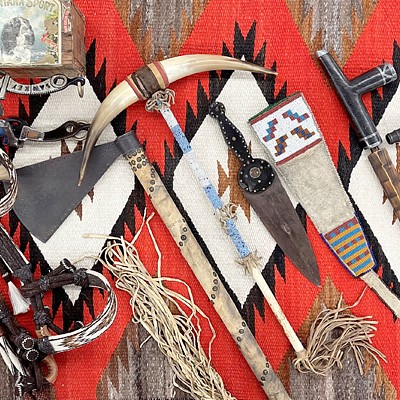American Indian Sorby Dag Knife & Sheath 19th C.
Two ways to bid:
- Leave a max absentee bid and the platform will bid on your behalf up to your maximum bid during the live auction.
- Bid live during the auction and your bids will be submitted real-time to the auctioneer.
Bid Increments
| Price | Bid Increment |
|---|---|
| $0 | $5 |
| $50 | $10 |
| $100 | $25 |
| $500 | $50 |
| $1,000 | $100 |
| $2,000 | $250 |
| $5,000 | $500 |
| $10,000 | $1,000 |
| $25,000 | $2,500 |
| $100,000 | $5,000 |
About Auction
May 15, 2021
Truly the Best In The West Sale from historic American Indian antiques, artifacts and weapons to history from the Old West along with luxury jewelry and Navajo turquoise. North American Auction Company tucker@naabid.com
- Lot Description
This is a very rare original American Indian Dag knife marked by English Blacksmith house I. Sorby dating to the 19th Century and paired with an amazing beaded dag sheath. The “step” designs on the white background in the beadwork suggest the piece is of Blackfoot / Blackfeet Native American Indian origin. This “Chief’s Grade” or “Presentation Grade” set features a highly polished Buffalo Great American Bison horn slab grip scales adorned with silver pins and is adorned with a silver hear inlay on one side and a circular copper moon on the reverse, the blade is marked “I Sorby” in their typical documented early documented touch mark / hallmark. For other examples of authentic Sorby touch marks and more information on Sorby Dag Knives see “Early Knives & Beaded Sheaths of the American Frontier” (1997) by John Baldwin for reference. The piece shows some minor discoloration on the blade, as well as some wear to the finish on the handle from true age and Native use. It is matched with a beautifully beaded Buffalo Indian tanned hide sheath that still has the original tie strap included and is highly decorated with beadwork in a geometric pattern showing all glass trade seed / cen 19th century beads of colors of chalk white, red, greasy blue, orange and pony early trade beads of cobalt, semi-transparent, and green. The base of the sheath shows a very unique drop of outward tapering hide which is beautifully fancy beaded on the border in large pony wound glass trade beads in similar colors. This style of ornate dag knife is referred to as a “Chief’s Grade” or “Presentation Grade” knife as they were given to Chief’s and tribal dignitaries during trade negotiations and treaty signings. The forged iron knife shows a raised median ridge running down the center of the blade, an early weapons features also seen on gunstock war clubs and lance blades. American Indian early dag knives are commonly referred to as “Beaver Paddle/ Beavertail” dag knives. This is due to the fact most dag knives were traded on the frontier along the Great Lakes region through the St. Lawrence seaway westward by early fur traders. From the Great Lakes region on westward the knives became very popular among the Northern Plains/Upper Plateau tribes such as the Cree, Metis, Blackfoot, Nez Perce, Chippewa/Ojibiwa and Shoshone. These were made to be killing weapons, this is why dag knives show a clean long double sided blade without any serration as they were for battle. Unlike other knives worn by Indian Warriors the dag knife would have been worn around the Indians neck on his chest. This is truly a very rare and early authentic set. Similar sets have sold at auction houses such as Cowan’s, Skinners and Bonhams for such prices as $75,000 at Cowan’s 4/5/2013 sale, $65,000 at Cowan’s 9/20/2013 sale, $70,725 at Skinner’s 2/6/2016 sale, $41,000 for a Sorby touch-marked plain handle dag from Brian Lebel’s Old West Show & Auction 6/23/2012 sale and $78,000 at Sotheby’s 5/6/2006 sale with the example being sold in this lot being of the same quality and rarity. The piece comes from the same collector as the Dag Knife sold by our company on 4/29/2017 for $10,200 (with premiums) that was authenticated by the Sotheby’s expert David Roche. The blade is touch-marked SORBY one one side. Sorby was the hallmark of John Sorby & Sons which was acquired by Lockwood Brothers Sheffield, England in 1844. Lockwood Bros. still operated out of their Arundel Street Factory but created the I&H Sorby items out of their Spital Hill Works factory. The Sorby touch-mark would be found on trade knives and dag knives which were exported to the American frontiersman and traded to the Native American Indians where they would alter the pieces to their liking. The knife measures 13 inches in length and the total length of the sheath including the drop is 20 inches in length.
- Shipping Info
-
North American Auction Company is proud to announce the opening of our new in-house, full-service shipping department. We have listened to you the customer and will now be handling all outgoing packages in our new shipping department. We are confident this new offering will allow for a smooth transition from auction block to your front step. We have partnered with preferred carriers to ensure a safe, efficient delivery that works best with your schedule. Please allow 14-21 days after complete invoice payment is made to package and ship your purchase. After you are notified of your winning bids from our company and your item invoice is paid in full our new shipping department will contact you. Make sure when signing up with our company that your preferred shipping information is up to date as this information will be used to estimate shipping cost. Once the items have been packaged our team will contact you for shipping payment. Shipping invoices and payment will be completely separately than the items invoice. Please notify the shipping department with any alternate request or instructions at mark@northamericanauctioncompany.com or 800-686-4216 ext. 3. For a shipping quote please contact the same information above. PLEASE NOTE a shipping quote price can fluctuate in price. Auction company is not responsible for actual shipping cost being higher than quoted shipping cost. Thank you for trusting North American Auction Co. with your bids and shipping. As our shipping department is brand new please understand that delays can be expected.
-
- Buyer's Premium



 EUR
EUR CAD
CAD AUD
AUD GBP
GBP MXN
MXN HKD
HKD CNY
CNY MYR
MYR SEK
SEK SGD
SGD CHF
CHF THB
THB














